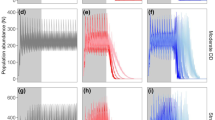Abstract
Mortality rates often depend on the size of a population. Using ideal free theory to model the optimal timing of reproduction in model populations, I considered how the specific relationship between density-dependent offspring mortality and population size affects the optimal temporal distribution of reproduction. The results suggest that the specific form of the relationship between density-dependent mortality and the number of offspring produced determines the degree to which reproduction within a population is synchronous. Specifically, reproductive synchrony decreases as density-dependent mortality becomes increasingly inversely related to the number of offspring produced and is highest when density-dependent mortality is directly density-dependent. These findings support the suggestion that predation pressure selects for greater reproductive synchrony in species where mortality is directly density-dependent, but does not affect the timing of reproduction in species with density-independent rates of mortality.
Similar content being viewed by others
References
Bouskila, A. and Blumstein, D.T. (1992) Rules of thumb for predation hazard assessment — predictions from a dynamic model. Am. Nat. 139, 161–176.
Cappoccino, N. and Price, P.W. (1995) Population Dynamics, New Approaches and Synthesis. Academic Press, London.
Forchhammer, M.C., Post, E. and Stenseth, N.C. (1998) Breeding phenology and climate. Nature 391, 29–30.
Foster, W.A. and Treherne, J.E. (1981) Evidence for the dilution effect in the selfish herd from fish predation on a marine insect. Nature 293, 466–467.
Ims, R.A. (1990) The ecology and evolution of reproductive synchrony. Trends in Ecology and Evolution 5, 135–140.
Iwasa, Y. and Levin, S.A. (1995) The timing of life-history events. J. Theor. Biol. 172, 33–42.
Kaitala, V., Ylikarjula, J. and Heino, M. (1999) Dynamic complexities in host-parasitoid interaction. J. Theor. Biol. 197, 331–341.
Levin, P.S. (1998) The significance of variable and density-independent post-recruitment mortality in local populations of reef fishes. Austr. J. Ecol. 23, 246–251.
Milinski, M. and Parker, G.A. (1991) Competition for resources. In J.R. Krebs and N.B. Davies (eds) Behavioural Ecology. Blackwell Scientific Publications, Oxford.
O'Donohue, M. and Boutin, S. (1995) Does reproductive sunchrony affect juvenile survival rates of northern mammals? Oikos 74, 115–121.
Royama, T. (1992) Analytic Population Dynamics. Chapman and Hall, London.
Ugolini, A. (1997) Crypsis and behaviour in sandhoppers: antipredator effectiveness in the water. Ethology 103, 41–46.
Author information
Authors and Affiliations
Rights and permissions
About this article
Cite this article
Richter, T. The effects of density-dependent offspring mortality on the synchrony of reproduction. Evolutionary Ecology 13, 167–172 (1999). https://doi.org/10.1023/A:1006642411683
Issue Date:
DOI: https://doi.org/10.1023/A:1006642411683




